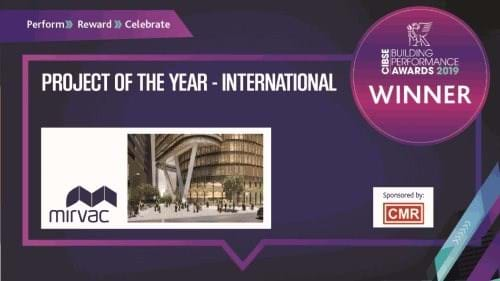
Project of the Year – International
Recognising the international project (new or refurbished) that most effectively demonstrates achievement of high levels of user satisfaction and comfort and outstanding measured building performance, energy efficiency and reduced carbon emissions.
Winner: EY Centre, Sydney, Australia – Mirvac
EY’s new office in George Street, at the Sydney Harbour end of Australia’s main financial and economic centre, is an exemplary project and should be a benchmark for all buildings, according to the judges.
The premium-grade tower, developed and constructed by Mirvac and designed by architects Francis-Jones Morehen Thorp (FJMT), has 33 office floors and about 38,983m2 of net lettable area.
The development has to contribute to Mirvac’s commitment to become net carbon positive by 2030 – producing more energy than it uses. To achieve this required a strong focus on good engineering and operational efficiency and commitment to capture performance learning opportunities in both the development and operational phase of the building.
This was achieved by careful attention to the air tightness of the building, including testing to create a new performance benchmark for Mirvac. The façade is the first high-performance closed cavity façade, which includes an internal, automated timber-blind system. This allows the use of more transparent glass to increase users connection with the outside while controlling light, sound and heat and reduce glare and energy use, all enhancing occupant comfort while reducing energy demand.
200 George St is the first fully LED-lit large premium-grade office building in Australia, requiring significant effort to specify appropriate LED luminaires in the open plan office spaces, due to rapid technology development at the time of design. It also features a fault detection and diagnosis package to detect control system anomalies and assist the building tuning process.
Sustainability and environmental performance objectives were a significant consideration in the development of the EY Centre, and included delivery on the joint owner’s sustainability goals, including Mirvac’s ‘This Changes Everything’ sustainability strategy.
Among the ratings achieved by the building are: a 6 Star Green Building Council of Australia (GBCA) Green Star Design rating; 6 Star GBCA Green Star As-Built rating; 5 Star NABERS Energy rating; and 4 Star NABERS Water rating. NABERS rates the building in use, not the design, so these required significant and externally verified efforts to deliver.
The project focused on delivering whole-of-life cost and value, with a conscious effort to avoid “eco-bling”.
Building features are integrated to provide the highest levels of customer health, wellbeing and productivity. These include a high-performance façade, to provide connectedness with the external environment; high levels of internal comfort, and indoor environment quality provided by the hybrid HVAC configuration; high amenity end-of-trip/last-mile facilities, including 307 bicycle spaces, 356 lockers and 28 showers.
The project also gives back to the local community through a monthly volunteer programme by the construction team to support a charity initiative to feed local homeless people.
During the construction phase, the team sought to protect the rich cultural heritage of the site; artefacts discovered during the archaeological excavation were incorporated into a display, and a sculpture was created for the building entrance, in consultation with indigenous elders.
Project team:
Building Services Consultant: Arup
Building Owner: Mirvac Property Trust / AMP Capital
Building Occupier: Ernst & Young / AGL / Mirvac
Project Manager: Mirvac Construction
Architect: Francis-Jones Morehen Thorp
Mechanical/Electrical Engineering Contractor: Climatech / Stowe
Main Contractor: Mirvac Construction
Investment/Property Company: Mirvac Asset Services
Developer: Mirvac Commercial Development
Facilities Manager: Mirvac
Building Management and Access Control Systems: Johnson Controls
Judges’ comments:
This is an exemplary project. Independent commissioning and the commitment to aftercare reinforces the true desire for a whole-life approach. This should be the benchmark for all buildings.
They have provided evidence of high social corporate responsibility and provided real-life working examples. While some companies just talk about social corporate responsibility, they are doing it.
Their community investment programme includes a monthly volunteer programme supporting an initiative to feed local homeless people, a profit-for-purpose café run by YMCA to reduce domestic violence against women; and facilitating employment opportunities for people exiting the justice system, ‘Mates on the Move’.
Finalists:
Aorangi House Revitalisation and Optimisation, Wellington, New Zealand – Beca
Early Learning Village, Singapore – AECOM
Golden 1 Center, California, USA – AECOM
Hillman Hall, Missouri, USA – BuroHappold Consulting Engineers
Musee d'Arts de Nantes, Nantes, France – Max Fordham
Silicon Valley Tech Office Drives Toward Zero, California, USA – Elementa Consulting
The National Gallery of Ireland, Dublin, Ireland – BDP
UC Santa Barbara San Joaquin Villages, California, USA – BuroHappold Consulting Engineers